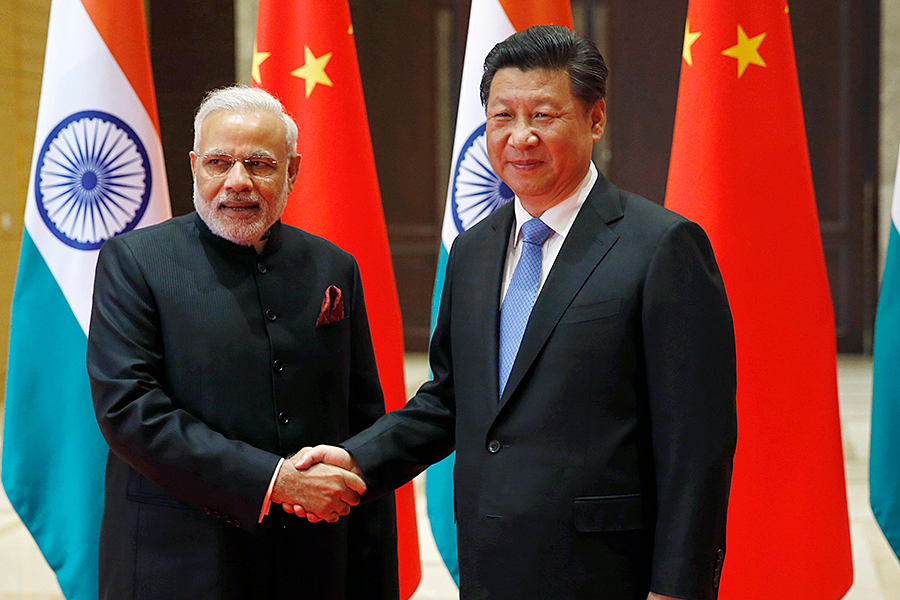For Asia's giants, trade trumps border dispute as leaders meet in China
Loading...
| Beijing
Indian Prime Minister Narendra Modi arrived in China Thursday for the third act in a diplomatic tightrope walk that is requiring him to balance his economic and strategic relationships with a range of regional rivals.
In recent months, Mr. Modi has steered India closer to the United States and Japan. This week he will seek to reassure his Chinese hosts that he is not ganging up with other regional powers to rein in Beijing’s rise.
In fact, he will want to talk business, not geopolitics. Since taking office a year ago, Modi has repeatedly promised to create more jobs, which means boosting industry and infrastructure, and is keen to attract Chinese companies to invest in his ambitious plans.
A stubborn border dispute, left over from a war between the giant neighbors more than 50 years ago, still dogs China’s relationship with India. But neither side wants to let that get in the way of better trade and investment ties.
They have decided they have more to gain from cooperation, says Ye Hailin, an expert on South Asian politics at the Chinese Academy of Social Sciences, a government-linked think tank in Beijing. “Resolving the border question is not a precondition for anything,” he says. “Neither side plans to fight over it, so there is no need to make too big a deal out of it.”
Chinese president Xi Jinping laid the groundwork for warmer ties with a visit to New Delhi last September, when he announced $20 billion worth of Chinese investment in industrial parks and high speed rail lines, among other projects.
Eight months on, however, those pledges have yet to borne fruit. Chinese businessmen complain that India, notorious for its chronic regulatory obstacles, is just as hard a place for them to do business as it is for any other foreign investor.
Lengthy land acquisition procedures in India mean that there is nowhere yet ready for the Chinese to build an industrial park. Engineers from Beijing are pressing India to let them start building a high-speed rail line from New Delhi to Chennai.
“India should be more open and cancel some of its restrictions,” says Ma Jiali, an India analyst at a think tank attached to the Party School of the ruling Communist Party’s central committee.
During Modi’s visit, he hopes that “both sides will take a more positive and active attitude.” On Thursday, Mr. Xi quickly set the tone. He praised China's warming ties with India when he welcomed Modi to his family's hometown of Xi'an.
A focus on trade
India is angling for yet more investment pledges, while the Chinese ambassador to New Delhi has spoken of the prospect for projects worth another $10 billion. But the Indians are frustrated by the way rising bilateral trade has benefitted China disproportionately.
Trade leapt from $42 billion in 2009 to $71 billion last year, according to Chinese figures. But nearly $60 billion of that came from Chinese exports. And though China trumpets its “South-South” cooperation with its fellow developing nation, it treats India similar to how industrialized countries have – selling machinery and manufactured steel and plastic products while importing mainly raw materials such as cotton, copper, and mineral ores.
New Delhi has asked Beijing to dismantle trade barriers to allow Indian high-tech companies to compete in the Chinese market. Indian pharmaceutical and information technology producers, who have done well elsewhere in the world, have been disappointed in China. India is seeking “more enlightened regulatory practice which would create a better trade balance,” India’s foreign secretary, Subrahmanyam Jaishankar, told reporters earlier this week.
Mutual mistrust, born of the brief Sino-Indian War of 1962, has long soured Indian-Chinese relations. But Modi’s pledges of reformist economic zeal and development have put a new spin on things; the new Indian leader is not letting security issues define the two countries’ relationship.
“India’s challenges today are primarily internal, not external,” says Nandan Unnikrishnan, deputy head of the Observer Research Foundation, a New Delhi think tank. The government’s top priority is jobs, he says, but it does not have enough money for the investments required to create them.
“China is critical, because they have the money,” Mr. Unnikrishnan adds.
Still, the unresolved border issue continues to fester. Eighteen rounds of talks over more than a decade have failed to do more than set up crisis management mechanisms.
“This will continue to undermine strategic mutual trust,” warns Zhang Li, who teaches international relations at Sichuan University in the southwestern city of Chengdu, China. Though both sides are addressing the problem with renewed vigor, he says, “that doesn’t mean they will find a solution quickly.”
For now, says Prof. Zhang, the best that can be hoped for is that “other aspects of the relationship go well.” If that happens, he adds, “perhaps that will provide a framework for more flexible approaches to the border dispute.”






